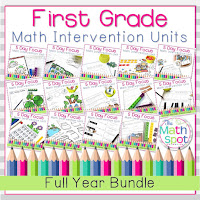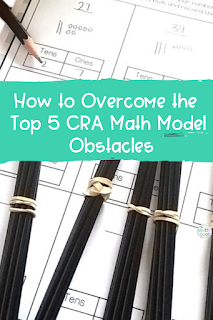This post contains affiliate links. This means that when you make a purchase, at no additional cost to you, I will earn a small commission.
There’s math theory and then there is real life in the classroom. You may LOVE the idea of the CRA math model but you may wonder how you can incorporate this type of model with a classroom full of students with varying needs.
Let’s dive into some common roadblocks to the CRA math model so that you can simply incorporate this practice into your teaching.

How to Choose Math Manipulatives
Right off the bat, you may be turned off by the use of so many hands-on materials in the CRA method. The materials management alone can be enough to make you second guess whether or not you want to go ahead with an activity.
As much as I would love to see all students with hands-on materials whenever needed and as frequently as possible- that’s not a realistic expectation in all classroom settings. You know your students best.
There are options that can make manipulative use less cumbersome.
- Model with hands-on materials whole group and then allow students to practice in a small group setting.
- Keep “math manipulative” kits in each students’ desks with materials periodically changed out to avoid material distribution during each and every lesson.
- Use hands-on materials with a partner to decrease the number of materials needed.
- Set up a “manipulative center” where students can access manipulatives as needed for independent work time.
How to Differentiate Math Instruction
Small. Group. Instruction.
I am NOT advocating for leveled small groups on a daily basis, however, there will be times when you are working on a specific skill in your classroom and you will have students who need guided practice at different levels. Take subtraction with ungrouping as an example.
- Some students may need linking cubes that they can quite literally take apart.
- Some students may have progressed to base ten blocks who are able to “make a trade”.
- Some students may feel comfortable with base ten blocks– they are working on making accurate place value drawings that match their work.
- Some students may be quite proficient with place value drawings and they are attaching their drawings to the standard algorithm.
Small groups will allow you to meet each of these groups of students exactly where they are.
Another option is to pose a question or situation to the group and strategically assign students to a given model. You may ask a group of students to solve the problem using counters and a math drawing, another group to solve using a math drawing and an equation and a final group to solve the problem using an equation and base ten blocks.
How to Decrease Dependence on Teacher
The CRA model requires that a teacher is in-tune with their students. A teacher knows where a student is performing and works in a skilled way to help the student to make connections and progress.
While this model requires skilled teacher work upfront, the purpose of the model is to move your students toward a more abstract understanding where they will not need the teacher to intervene!
Trust the process. More targeted intervention on the part of the teacher upfront in order to support students in using the most appropriate model will ultimately lead to less teacher dependence down the line!
How to Incorporate Problem Solving
Another misconception about CRA is that it doesn’t involve problem-solving. Although it would be possible to use CRA to teach a procedure, that is not the goal!
Problem-solving and story problems are a prime opportunity for this strategy. Consider the following problem:
I have $0.48 cents in my pocket made up entirely of dimes and pennies. How many dimes and pennies might I have?
This problem can be solved while honoring the CRA math model. Ask your students to model the story using base ten blocks and to record the different combinations of dimes and pennies both in place value drawings and words.
How to Assess
“If I give my students
linking cubes to use during instruction, do I need to give them linking cubes during the assessment?”
No.
Or yes.
It depends!
Take a look at your standards, talk to your grade level about expectations and allow those factors to drive your decision making around assessments. There are Common Core standards that state “Use objects, pictures and/or numbers to…” in those cases, it would be very appropriate to allow your students to use a hands-on material during an assessment.
Other standards might require that your students are able to demonstrate an understanding using “strategies based on place value” with no wording around using objects. In that case, it may be your goal to use hands-on materials in order to support your students towards higher-level understandings. In that case, you want your students to be prepared to demonstrate proficiency without any hands-on materials.
The CRA Math Model is just that- a model for instruction- not a life sentence to a specific prescribed set of teaching steps. If you are noticing where your students are performing, thinking about the models that will be most supportive and helping your students to move to more abstract thinking you are 100% on the right track!
Related Resources:
Pin For Later:








